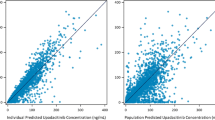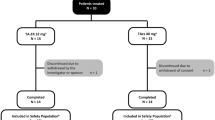Summary
Nabumetone is a nonsteroidal anti-inflammatory drug (NSAID) of the 2,6-disubstituted naphthyl-alkanone class. Nabumetone is metabolised to an active metabolite 6-methoxy-2-napthylacetic acid (6-MNA) which is a relatively selective cyclo-oxygenase-2 inhibitor that has anti-inflammatory and analgesic properties. Nabumetone and its metabolites bind extensively to plasma albumin.
Nabumetone is eliminated following biotransformation to 6-MNA, which does not undergo enterohepatic circulation and the respective glucoroconjugated metabolites are excreted in urine. Substantial concentrations of 6-MNA are attained in synovial fluid, which is the proposed site of action in chronic inflammatory arthropathies. A smaller area under the plasma concentration-time curve (AUC) is evident at steady state as compared with a single dose; this is possibly due to an increase in the volume of distribution and saturation of protein binding. Relationships between 6-MNA concentrations and the therapeutic and toxicological effects have yet to be elucidated for this NSAID.
Renal failure significantly reduces 6-MNA elimination but steady-state concentrations of 6-MNA are not increased, possibly because of nonlinear protein binding. Elderly patients with osteoarthritis demonstrate decreased elimination and increased plasma concentrations of nabumetone as compared with young healthy volunteers. Rheumatic disease activity also influences 6-MNA plasma concentrations, as patients with more active disease and lower serum albumin concentrations demonstrate a lower area under the plasma concentration versus time curve. A reduced bioavailability of 6-MNA in patients with severe hepatic impairment is also evident.
Dosage adjustment may be required in the elderly, patients with active rheumatic disease and those with hepatic impairment, but not in patients with mild-to-moderate renal failure.
Similar content being viewed by others
References
Jeremy JY, Mikhailidis DP, Barradas MA. The effect of nabumetone and its principal active metabolite on in vitro human gastric mucosal prostanoid synthesis and platelet function. Br J Rheum 1990; 29: 116–9
Goudie AC, Gaster LM, Lake AW, et al. 4-(6-Methoxy-2-naphthyl)butan-2-one and related analogues, a novel structural class of antiinflammatory compounds. J Med Chem 1978; 219(12): 1260–4
Friedel HA, Todd PA. Nabumetone: a preliminary review of its pharmacodynamic and pharmacokinetic properties, and therapeutic efficacy in rheumatic diseases. Drugs 1988; 35(5): 504–24
Friedel HA, Langtry HD, Buckley MM. Nabumetone: a reappraisal of its pharmacology and therapeutic use in rheumatic diseases. Drugs 1993; 45(1): 131–6
Ray JE, Day RO. High-performance liquid Chromatographic determination of a new anti-inflammatory agent, nabumetone, and its major metabolite in plasma using fluorimetric detection. J Chromatogr 1984; 336: 234–8
Maleev A, Vlahov V, Gruev I, et al. Liver insufficiency as a factor modifying the pharmacokinetic characteristic of the preparation nabumetone. Int J Clin Pharmacol Ther Toxicol 1986; 24(8): 425–9
Torre D, Sampietro C, Maggiolo F. Blood and tissue fluid levels of a new non- steroidal anti-inflammatory preparation of nabumetone. J Int Med Res 1987; 15: 368–73
Daigneault EA, Ferslew KE, Stanton P. Bioequivalence study of nabumetone: tablet versus suspension. Am J Med 1987; 83 Suppl. 4B: 11–4
Kendall MJ, Chellingsworth MC, Jubb R, et al. A pharmacokinetic study of the active metabolite of nabumetone in young healthy subjects and older arthritis patients. Eur J Clin Pharmacol 1989; 36: 299–305
Miehlke RK, Schneider S, Sorgel F, et al. Penetration of the active metabolite of nabumetone into synovial fluid and adherent tissue of patients undergoing knee joint surgery. Drugs 1990; 40 Suppl. 5: 57–61
Haddock RE, Jeffrey DJ, Llloyd JA, et al. Metabolism of nabumetone (BRL 1477) by various species including man. Xenobiotica 1984; 14(4): 327–37
Von Schrader HW, Buscher G, Dierdorf D, et al. Nabumetone. A novel anti-inflammatory drug: the influence of food, milk, antacids, and analgesics on bioavailability of single oral doses. Int J Clin Pharmacol Ther Toxicol 1983; 21(6): 311–21
Von Schrader HW, Buscher G, Dierdorf D, et al. Nabumetone. A novel anti-inflammatory drug: bioavailability after different dosage regimens. Int J Clin Pharmacol Ther Toxicol 1984; 22(12): 672–6
Nandi KL, Corless D, Undre NA, et al. A study of the pharmacokinetics, effectiveness, and tolerance of nabumetone, a novel anti-inflammatory drug, in elderly patients. Roy Soc Med Int Sym Ser 1985; 69: 163–72
Hamdy RC, Price JD, Undre NA, et al. The pharmacokinetics of nabumetone in elderly patients. Roy Soc Med Int Sym Ser 1985; 69: 173–9
Boelaert JR, Jonnaert HA, Daneels RF, et al. Nabumetone pharmacokinetics in patients with varying degrees of renal impairment. Am J Med 1987; 83 Suppl. 4B: 107–9
McMahon FG, Vargas R, Ryan JR. Nabumetone kinetics in the young and elderly. Am J Med 1987; 83 Suppl. 4B: 92–5
Terziivanov D, Maleev A, Vlahov V. Nabumetone (BRL 14777) presystemic elimination and disposition in patients with liver impairments. Int J Clin Pharmacol Ther Toxicol 1987; 25(4): 208–13
Brier ME, Aronoff GR. Multiple dose kinetics of nabumetone in renal impairment [abstract]. Clin Res 1990; 38: 520
Brett MA, Buscher G, Ellrich E, et al. Nabumetone: evidence for the lack of enterohepatic circulation of the active metabolite 6-MNA in humans. Drugs 1990; 40 Suppl. 5: 67–70
Brier ME, Sloan RS, Aronoff GR. Population pharmacokinetics of the active metabolite of nabumetone in renal dysfunction. Clin Pharmacol Ther 1995; 57: 622–7
Hyneck ML. An overview of the clinical pharmacokinetics of nabumetone. J Rheumatol 1992; 19 Suppl. 36: 20–4
Davies NM, Anderson KE. Clinical pharmacokinetics of naproxen. Clin Pharmacokinet 1997; 32(4): 321–5
Hyneck M, Audet P, Nichols A, et al. Steady-state pharmacokinetics an ex vivo protein binding of nabumetone. Clin Pharmacol Ther 1993; 53: 212 PIII-22
Bourke B, Undre NA, Thawley AR. An investigation into the penetration of nabumetone and its metabolites into synovial fluid in patients with rheumatoid arthritis. Roy Soc Med Int Sym Ser 1985; 69: 31–5
Freeman AM, Undre NA, Thawley AR, et al. Plasma and synovial fluid concentrations of nabumetone and BRL 10720 in patients given nabumetone. Roy Soc Med Int Sym Ser 1984; 69: 40–2
Davies NM, Wallace JL. Non-steroidal anti-inflammatory drug-induced gastrointestinal toxicity: new insights into an old problem. J Gastroenterol 1997; 32(2): 127–33
Blower P. The science — equivalent efficacy and diminished risk. Eur J Rheum Inflamm 1991; 11: 37–57
Reuter BK, Davies NM, Wallace JL. NSAID-enteropathy in rats: role of epithelial permeability, bacterial load, and enterohepatic circulation. Gastroenterology 1997; 112(1): 109–17
Bjarnason I, Fehilly B, Smethurst P, et al. Importance of local versus systemic effects of non-steroidal anti-inflammatory drugs in increasing small intestinal permeability in man. Gut 1991; 32: 275–7
Devlin J, Moots R, Andrews D, et al. High intestinal permeability in patients with inflammatory arthritis is more strongly associated with any NSAID therapy than with diagnosis or disease activity. Arthritis Rheum 1996; S280: 1513
Vane JR. Inhibition of prostaglandin synthesis as a mechanism of action for aspirin-like drugs. Nature New Biol 1971; 231: 232–5
Whittle BJR, Vane JR. A biochemical basis for the gastrointestinal toxicity of non-steroid anti-rheumatoid drugs. Arch Toxicol 1984; 7: 315–22
Meade EA, Smith WL, DeWitt DL. Differential inhibition of prostaglandin endoperoxide synthase (cyclooxygenase) isozymes by aspirin and other non- steroidal anti-inflammatory drugs. J Biol Chem 1993; 268(9): 6610–4
Davies NM, Wallace JL. Selective inhibitors of cyclooxygenase 2: potential in elderly patients. Drugs Aging 1996; 9(6): 406–17
Lemmel EM, Bolten W, Burgos-Vargas R, et al. Efficacy and safety of meloxicam in patients with rheumatoid arthritis. J Rheumatol 1997; 24(2): 282–90
Bjarnason I, Macpherson A, Rotman H, et al. A randomized, double-blind, crossover comparative endoscopy study on the gastroduodenal tolerability of a highly specific cyclooxygenase-2 inhibitor, flosulide, and diclofenac. Scand J Gastroenterol 1997; 32(2): 126–30
Reuter BK, Asfaha S, Buret A, et al. Exacerbation of inflammation-associated colonic injury in rat through inhibition of cyclooxygenase-2. J Clin Invest 1996; 98: 2076–85
Mizuno H, Sakamoto C, Matsuda K. Induction of cyclooxygenase 2 in gastric mucosal lesions and its inhibition by specific antagonist delays healing in mice. Gastroenterology 1997; 112: 387–97
Voss GD. GI bleeding associated with nabumetone. Am J Hosp Pharm 1994; 51: 2506–8
Eberhardt CE, Coffey RJ, Radhika A, et al. Up regulation of cyclooxygenase 2 gene expression in human colorectal adenomas and adenocarcinomas. Gastroenterology 1996; 107: 1183–8
Kargman SL, O’Neill GP, Vikers PJ, et al. Expression of prostaglandin G/H synthase-1 and -2 protein in human colorectal cancer. Cancer Res 1991; 55: 2556–9
Rogers J, Kirby LC, Hempelman SR, et al. Clinical trial of indomethacin in Alzheimers disease. Neurology 1993; 43: 1609–11
Onoe Y, Miaura C, Kammakayashik T. IL-13 and IL-14 inhibit bone suppressing cyclooxygenase-2 prostaglandin synthesis in osteoblasts. J Immmunol 1996; 156: 758–64
Fitzgerald DE. Double-blind study to establish whether there is any interaction between nabumetone and warfarin in healthy adult male volunteers. Roy Soc Med In Cong Sym Ser 1985; 69: 47–53
Author information
Authors and Affiliations
Corresponding author
Rights and permissions
About this article
Cite this article
Davies, N.M. Clinical Pharmacokinetics of Nabumetone. Clin Pharmacokinet 33, 403–416 (1997). https://doi.org/10.2165/00003088-199733060-00001
Published:
Issue Date:
DOI: https://doi.org/10.2165/00003088-199733060-00001




